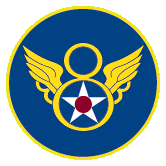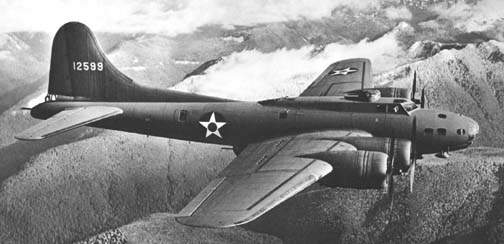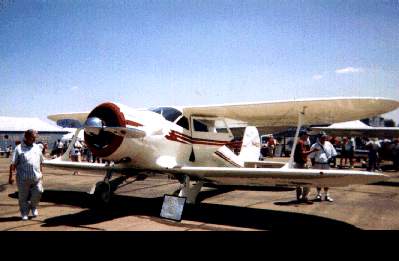 "BIG TIN BIRD"
"BIG TIN BIRD"
(And Other Squadron Hacks Used By The 20th. FG)
 A Boeing B-17E Flying Fortress like the one used by the 20th. Fighter Group � � "Why would a four engine bomber be on a single engine fighter base in England? The "Big Tin Bird" was a RB-17E that was brought to station 367 (King's Cliffe, home of the 20th. Fighter Group) for the purposes of towing sleeve targets for gunnery practice for those P-51 pilots who had not had combat flying or had only a few missions over the continent. For about a week or ten days it was flown by a bomber crew. That crew was returned to the States and left the Fortress on the base. S/Sgt. John "Jack" Donovan and I were given the assignment of taking care of the plane on the ground. When the original flight crew departed, Col. Wilson, who had just returned from a German P.O.W. camp, commandeered the fort for use as a target towing plane. S/Sgt. Donovan and I were to become ground crew-flight crew for the Colonel's new acquisition. � � "The 'Bird' had flown several missions before it had been declared war weary and removed from comabt duty. It was painted in camouflage colors. The skin surface was quite rough and weathered. Col. Cy prevailed on some paint crew to spray a coat of clear lacquer on the outer surface. With the same engine power settings, this added fifteen miles per hour to the cruising speed of the plane. By the standard of a pilot who had been flying Mustangs and Lightnings, the one hundred eighty-five miles per hour was indeed lumbering along. � � 'With the bomb bay floored over with thick plywood and some salvaged seats installed, it became the passenger palne from Station 367. Numerous trips were made to Scotland for necessary supplies for the Officers Club that could be obtained locally. France, being the champagne center of the world, was a likely place to go in search of refreshments. On the first trip we landed on a grassy runway that had been used as an advanced fighter base near Grenoble. The Mayor of the town and others came to greet us, but we were informed that Rheims was the place to go for champagne. I recall one of our passengers, I think it was Captain Tatum, who tried to converse with a little boy about ten years old in his pure college French. After two attempts to understand the Captain, the little boy said in very correct English, 'What did you say, Captain?' � � "On a subsequent flight to Rheims where we landed on steel matting, Col. Wilson was informed that champagne was reserved for troops on the continent. How many of you ever knew that Col. Cy commanded a group of two thousand men on the continent after V.E. Day? We drew their champagne allowance and headed for Merry Ole England. After thus being established, regular runs were made. What would our English friends have thought about the lack of proper import duty being collected on imported spirits? Later, S/Sgt. Donovan and I found a brewery in Nuremberg whose output was also for the troops onthe continent. I still remember Col. Wilson driving an open cab autocar tractor pulling a flatbed trailer loaded with kegs of beer from that place to the Big Tin Bird. � � "About this time airplanes with a great many hours of operating time on them were being salvaged. Orders were received and ignored to bring the old 17-E to the reclaim center for salvage. After that, the base was informed that a crew would pick up the aircraft. Upon hearing this, Col. Cy told me, 'Joe, you had better disable our plane, or they will get it.' � � "When the pickup crew arrived at King's Cliffe, they found an airplane with the number one engine missing a prop. I sometimes wonder what they would have thought had they found a B-17 prop on a dolly in the woods behind the Engineering hangar. Some short time later, a direct order was issued by someone who outranked Col. Cy for him to fly the Bird in for salvage. That day he and I flew the Bird on its last flight. � � "But as Josh Billings once wrote in the 1800's, 'After man has once traveled fast, he is never content to go slow again.' Another B-17 was located by Col. Wilson. It was the latest model of the Flying Fortress, with about forty hours logged flying time. No guns had ever been installed, and it was indeed a new plane in glistening unpainted finish. This one was flown until the time that the base was being readied for the departure of the 20th. Fighter Group. � � "Another airplane of interest was a P-38. As I recall, it was a J-Model, but I don't remember which squadron's letters it had on it. After the Lightnings were replaced by the Mustangs of the 20th. Fighter Group, there were supposed to be none in the U.K. About this time one of my duty assignments was to inspect aircraft down away from the base to determine if repair at the sight was feasible or if the aircraft was flyable. One of the 20th. pilots had landed a P-51 on a semi-abandoned air base near New Market. When I reachedthe station by Jeep, I found it manned by a R.A.F. warrant officer and a few airmen. I was shown the 20th. Mustang and then the officer said to me, 'We have another of your aircraft in the hangar.' When he showed it to me, it turned out to be a Lightning with 20th. Group markings. He explained to me that a pilot had landed it there with no defects or troubles and had said he would be back the next day to pick it up. He had never returned after several weeks. As I recall, ferry pilots came to King's Cliffe to fly the P-38s of the base. � � "When I returned to Station 367 and reported my find to Station Engineering, Officer Major Bell Lamek contacted someone in Headquarters Squadron and the airplane was brought back to King's Cliffe and flown as a 'pleasure craft.' It was usually found outside the Service Group's hangar. The Inspector General's Staff found out about this palne on the base and ordered its removal. � � "The A-20 marked KI-E failed to return after overrunning a runway on the continent and damaging the nose gear. I have often wondered who the two fighter pilots were with whom I made the trip to Italy and Silcily. One was the pilot while the other acted as the naviagtor. The one who was reading the map as we approached one of the Mediterranean Islands said, ' Fly three thosand feet and you will clear everything on the island.' After climbing to ten thousand feetand going over the island, it was discovered that the map was in French and the three thousand feet was in reality three thousand meters. I have always been grateful it was not a night flight."
--M/Sgt. Joseph S. Thompson, 882nd Air Engineering Squadron � � "I remember well the 'Big Tin Bird' which Col. Cy Wilson comandeered for use as a target towing plane, and I had the pleasure of flying as Cy's co-pilot on several missions. However I do not recall any towing missions, but I certainly remember the mercy missions to Scotland and the continent for necessary supplies. We finally lost this bird to the reclaimcenter for salvage, but somehow Col. Cy showed up with a new B-17 which made a fewmercy missions until an order was received to return this one to salvage also. I made this trip again as Cy's co-pilot, and got to sit in on the discussion between Col. Cy and the Big Wheel reclaim officer about Col. Cy returning the Bird to the United States. I sat there dreaming about flying this thing across the ocean loaded with personnel and their belongings until the reclaim officer finally threw us out. � � "In the meantime, we 'obtained' an A-20 and two P-47 Thunderbolts, plus a small cargo aircraft that carried about eight people. We also had an AT-6 trainer. We flew these aircraft around the country and had a ball. � � "One day Maj. Jack Price -- our executive officer-- received a request from Sgt. Joe Thompson and another airman from the 822nd. for transportation to Sicily. Maj. Price asked me to go with him in the A-20 as I was checked out and flew it regularly. We flipped a coin and Maj. Price won the takeoff from King's Cliffe while I rode in the nose as map reader/navigator. Joe Thompson and friend rode in the back gunnery cockpit and had a good view over all. We made it to Marsaille, France with no problem. There we switched positions with me going as pilot. We picked up a heading for straight across the Meditteranean Sea -over Corsica to either Rome or Naples. For awhile I flew right on top of the water. The boys in the back probably got second thoughts about flying with two fighter pilots. Anyway, the island loomed up in front of us and I asked Jack how hight should I level off to go over the top. He said the map shows 3,000 feet. Now these maps were something we had scrounged and we were not very familiar with them (no excuse). Pretty soon I was level at 3,000ft. and said, 'Hey Jack these mountains are still going up.' I began a gentle climb while he pondered this problem, and the boys in the back were positive they would never fly with fighter pilots again. Like Joe said, 'He was forver grateful that it was not a night flight.' I was enjoying it, however, as I knew I could go around. I finally leveled off at 10,000ft. and we all had a great view of the islands as I wove around the peaks and slid down the other side into Naples. We refueled, jumped on doen to Sicily and let out two happy guys. Jack and I looked over our collection of various maps and found the one across the Mediterrreanena was in meters. � � "A few weeks later, my friend Joe Mansker flew the A-20 to France on some kind of mission or other, and the brakes failed on landing. He ran off the runway and damaged the nose gear. Joe had to leave it there. This answers two questions M/Sgt. Joe Thompson had -- who were the two pilots who flew him to Sicily -- and who flew the A-20 last. I have no idea what happened to the other oddball airplanes, but we certainly enjoyed them." -- Capt. Ted Slanker, 55th.FS King's Cliffe Remembered Spring 1992 Issue. � � "...I often flew with Cy Wilson and, I am sure with Ted (Slanker, see above) as well, ostensibly as the navigator for the craft, although in reality they sure as he** didn't need me. I'll never forget our acknowledgement by the tower at the likes of Edinburgh or Aberdeen - the Scottish brogue came through loudand clear, 'Big Tin Birrrrd, you are cleared to land,' they would respond to our requests. � � "Among the many serious missions we flew were the rescue of fresh eggs and black market Scotch in Aberdeen, the retrieval of Cliquot Club champagne and fine wines in Rouen, the on time delivery of our ad hoc baseball team to contests at other 8th. Air Force bases. And then of course, there was the fabulous mission to Munich where we loaded the beautiful bird with many cases of Lowenbrau beer and the brewmaster's fancy German motorcycle. We indeed had alot of fun.
--Capt. Henry W. Howard, Group S-2 "...When we met at Duxford I intended to tell you that the Big Tin Bird was a very famous Fortress. It was, in fact, the lead plane flown by Major Tibbets (who later piloted the "Enola Gay" on the first atomic bomb mission against Hiroshima, Japan,) on the first 8th. heavy AF bomber raid,17 August, 1942. At that time 41-2578 was supposedly nicknamed "Butcher Shop." It was retired from operations and served with many 8th. AF outfits before coming to the 20th. It was the longest serving B-17 in the 8th. AF and was finally broken up in this country (The UK) in the summer of 1945." --Roger Freeman, Letter to Jack Ilfrey, 16 September, 1992
"...Regarding the Hack a/c we had, I was checked out in The Oxford and used to ferry people around in it.We had a Miles Majestic for awhile and Major Carl Jackson and I flew it a few times. Big Red Snow left K.C.(King's Cliffe) one fine day in the Percival Proctor and arrived back at the Hut that night via the rit rail system.He didn't understand the fuel system and ran out of fuel and sacked it up. No one was hurt." --Capt. James Bradshaw, 79th.FS, 20th.FG, in a letter to David G. Knight |

A Beechcraft Staggerwing similar to the one used by the 20th.(Photo by:Syd Edwards)
20th. Fighter Group Transports and General Hacks
| N/A MC-? | "Easy Pickup" | Douglas C-47 | Final Disposition Unknown |
| 44-70290 | N/A | U-64 Norseman | Final Disposition Unknown |
| 41-2578 LC-Z | "Big Tin Bird" | Boeing RB-17E | Salvaged |
| AL-381 KI-E | N/A | Douglas A-20 Havoc | Abandoned after landing accident |
| 91-39 | N/A | Beechcraft Staggerwing | Final Disposition Unknown |
| N/A | Vultee A-35 Vengeance | N/A | Final Disposition Unknown |
RETURN TO THE 20TH.FG
Unless otherwise noted, all content � copyright The Art of Syd Edwards 1998-1999. All rights reserved and reproduction is prohibited.

